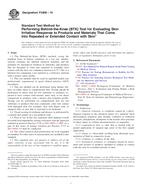1.1 The Behind-the-Knee (BTK) method, using the popliteal fossa of human volunteers as a test site, simultaneously evaluates the inherent chemical irritation, and the potential for mechanical irritation of substrates and products that are designed to come into repeated or extended close contact with the skin (see validation references 1-7). This is a bilateral test comparing a test material to a reference material with a known safety profile.
1.2 This test method shall be used by qualified health care professionals experienced in good clinical practice (GCP) procedures.
1.3 This test method can be performed using human subjects on either intact or compromised skin. Testing should be performed on intact skin for test substrates or products expected to have contact with normal, intact skin, or for direct comparison to products with a known skin irritation profile. Testing can be performed on compromised skin for test substrates or products that may commonly come into contact with damaged skin (for example, skin with diaper rash, or chapped skin) or skin that is expected to be hydrated.
1.4 Visual scoring of erythema and dryness is performed by a trained skin grader on a pre-defined scale.
1.5 Prior to use in this test, materials shall undergo overall favorable biocompatibility testing consistent with the approach outlined in protocol Practice F748 or ISO 10993-1:2009. As a part of this series of testing, irritation per Practice F719 or ISO 10993-10 shall be conducted.
1.6 The values stated in inch-pound units are to be regarded as standard. No other units of measurement are included in this standard.
1.7 This standard does not purport to address all of the safety concerns, if any, associated with its use. It is the responsibility of the user of this standard to establish appropriate safety and health practices and determine the applicability of regulatory limitations prior to use.
Product Details
- Published:
- 10/15/2010
- Number of Pages:
- 23
- File Size:
- 1 file , 1.9 MB
